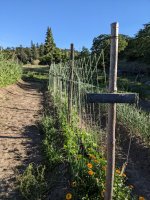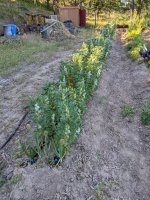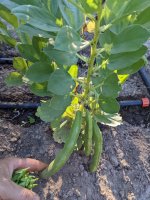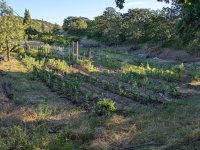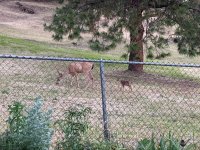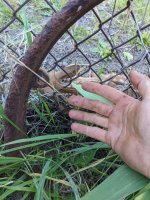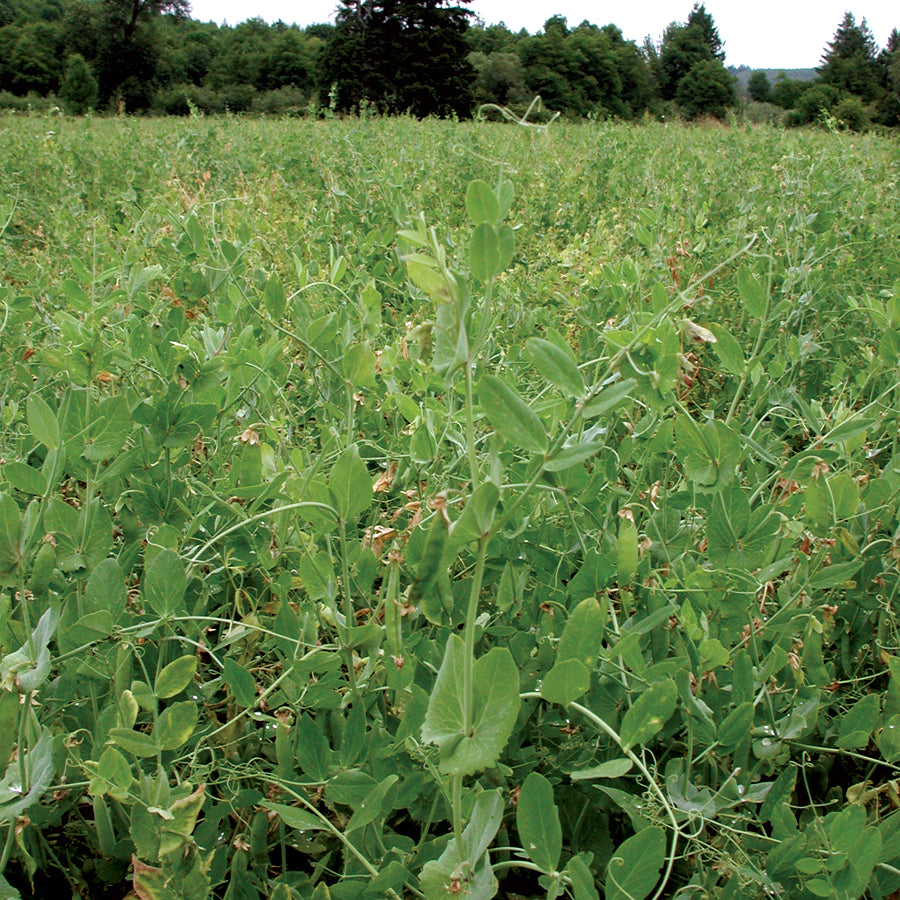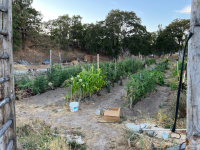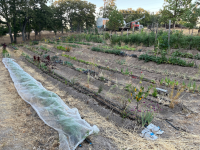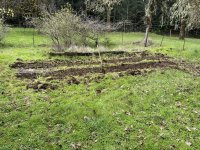Mike Stafford
Member
- Messages
- 2,352
- Location
- Coastal plain of North Carolina
I was able to amend the soil with compost and lots of organic material and that is why I was able to dispense with the fertilizer. I made it a habit to not turn the soil without adding something to it; compost, leaves, leaf mold, manure, grass clippings etc. etc. etc. Of course manure is fertilizer in its most basic form.As you've probably found.. skipping the sprinkler was key to that. There's no point in watering weeds. We do still have a lot of weeds but water and bed management has helped keep them to a dull roar. It's been pretty interesting going into entirely new soil, the spaces I had turned last year and we were diligent on weeding were MUCH less of a problem than the freshly turned spaces. As they say "One year of seeds is ten years of weeds" but there's a bit of a drop off curve on the density. One spot we didn't get to very well in the lower field had a big patch of grass go to seed last year and boy howdy it's back this year in that same spot so.. you can really tell the difference. The owner also tilled the lower patch which took the bindweed (Convolvulus arvensis) that had made it and spread the roots more evenly around... so THAT didn't help either haha.. I've gotten it chopped back some but that stuff re-generates from even a tiny bit of root so it's been a real pain.
I have about 2500' of 5/8" drip deployed across the two garden plots. I grew up using row-adjacent flood irrigating which works in a similar fashion but given the irregular slopes, and water timing availability drip line seemed like a better choice. It's not ideal especially with the soil problems, we have had quite a bit of seed germination issues due to poor moisture retention/distribution (a combination of a mister system to get germination going then switch to drip might work..) but once crops are established it's a good way to go. We've ended up starting a lot of stuff we'd otherwise direct plant (lettuce, small cabbage family, green onions, etc... not root crops like beets/carrots though) because of this.
While I'm with you on this in principal, in practice without fertilizer this plot would yield pretty much nothing hah. I don't think I've ever tried to work with such depleted soil before. There was very very little organic material. It was wildly deficient not just in the NPK macro nutrients.. but also basically all of the micro nutrients especially sulfur (which is borderline a macro) and boron (which is apparently a problem all over E Oregon.. who knew). Plus the soil texture is really really terrible. The majority of the "dirt" is twice eroded clay where it's rock that turned to clay, that was reformed into clay/sand rock and is now eroding back into clay again. There are basically no organics and and rock nutrients that might once have been in it have long washed out.. excepting Potassium which was moderate-high because of poor watering practices salting the soil.
We did bring in 9 yards of outside compost last year of which about half went on this plot and half went on some berries and into a house garden plot. That wasn't scaling well though... I've also used up most of the freely available downed rotten wood in the one Huggle so long term I'm working with the owners on better plans for in-situ biomass production.
So we've had to use more commercial fertilizer than I might normally indulge in. Primarily we're using an organic 4:3:2 (pelletized chicken byproducts) but have also had to use a lot of other stuff to keep it going.
The difference between second year (and the very heavily modified) plots that have some organics in them and the first year plots was also pretty interesting to see. Where we had planted and cover cropped and .... ... the moisture retention was significantly better, the soil texture went from "mostly brick like lumps" to "crumbly and friable with only intermittent brick like lumps..".
- bone meal (cal/phos) which is an excellent intermediate time delivery phosphorous + calcium so great for tomatoes
- actual rock cal/phos (which is slower release), and also some chelated calcium to knock back blossom end as a spot application
- Some super phosphate to kick the tomatoes (and it turns out luffa gourds... which is another story...) into production.
- Gypsum (several 100lbs of gypsum) for sulfur and calcium and we hoped for some of its clay breaking properties (might have worked.. didn't make it worse anyway)
- Solubor for boron (a little goes a loooong ways)
- Azomite and green sand for other micronutrients
- 15-0-0 Calcium Nitrate which provides a form of cold weather available nitrogen that literally made our early cabbage family (bok chow/chinese cabbage/etc..) possible.
- 20-0-0 Ammonium Sulfate which provides both nitrogen and sulfur for the corn patch. Corn very visibly complains about sulfur deficiency by showing yellow stripes on the leaves, once you see the stripes it's generally to late for that years crops. It's been kind of interesting to see where I put down enough.. versus where I didn't the difference is pretty marked where you'll see some with nice green leaves and the plants right next to them are visibly striped.
I also aggressively cover cropped some sections in fall/winter/spring with some different mixes. The definite winner in our location for late winter/early spring cover cropping was fava beans, possibly mixed with some forage radish for deep soil penetration (the forage radishes are worth growing for winter radish and also some super tasty greens anyway). We planted a lot of "bell beans" which are a smaller variety plus some full sized in more carefully tended plots.. both are great as both a very early green bean and a bit later as a shell bean, so for starters you get beans 1-2 months earlier than any other bean. They also put down a lot more roots and organic matter than most of the other cover crops in this poor soil plus they at least tried to fix some nitrogen (the field peas seem to have fixed a bit more .. but it's hard to be entirely sure - the favas improved the soil texture a lot more anyways which at this point is kind of the limiting factor).
The property owners have a 2 acre plot they need to pull cherries off of because of a cherry disease, I've been trying to convince them to do a soil remediation program there before doing anything else. Based on my experiments in the small plot.. First would be fall/winter nitrogen fixing crops after amending with a Phosphate and micronutrient source and maybe a wee bit of an initial nitrogen supplement to get the baby plants started. This would be primarily fava's and some soil penetrating helpers like forage radish and mustards and maybe an overwinter boimass grain like rye or triticale. Second would be a spring nitrogen crop addition (field peas) mixed with nitrogen holding (buckwheat) and biomass (oats probably). Then over summer put in a heavy biomass producer like a sterile sourghumXSudangrass hybrid (which is a massive clay buster as well) which would probably need a supplemental nitrogen feed. Once that was dug in another round of winter nitrogen & biomass planting.. That takes it mostly out of rotation for a year.. but I think you could probably sell at least some of the fava's as a specialty item in the spring to recover a bit of it.
Your soil sounds even worse than what I was dealing with. I live on the coastal plain so all of the nutrients were long ago washed away or consumed by time. I had to amend the soil or I would have been watering daily. There was nothing to hold moisture in the sand. I also found it necessary to add calcium and lime to the garden soil regularly.
I used to plant red clover to hold the soil over the winter and then till it in. I tried rye but it grew in my beds to monstrous heights and was difficult to till in.
I did try the soaker hoses and they worked okay but being lazy I found that flood irrigation was much easier as the water soaked into the sides of my raised beds.
At this point I am not able to do all I used to do in my garden and have downsized to a smaller tiller and a cultivator. I still compost and add it in every year. I love my garden and I loved working in it but my health has put limitations on lots of things that I used to do.
You have a great garden and I am sure you enjoy it.



